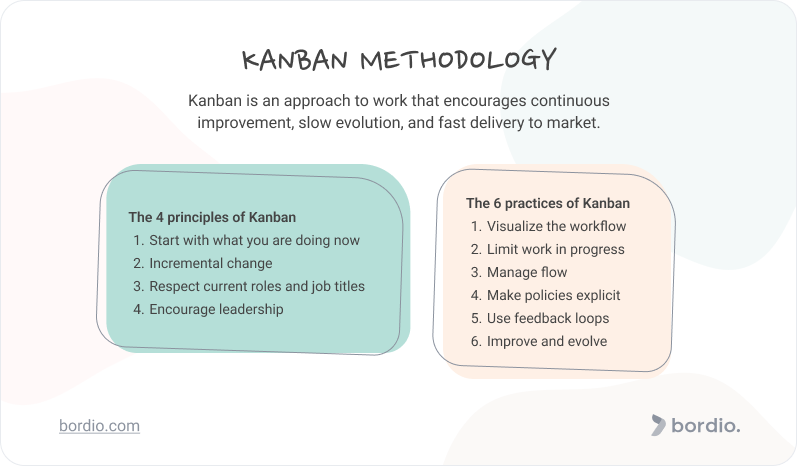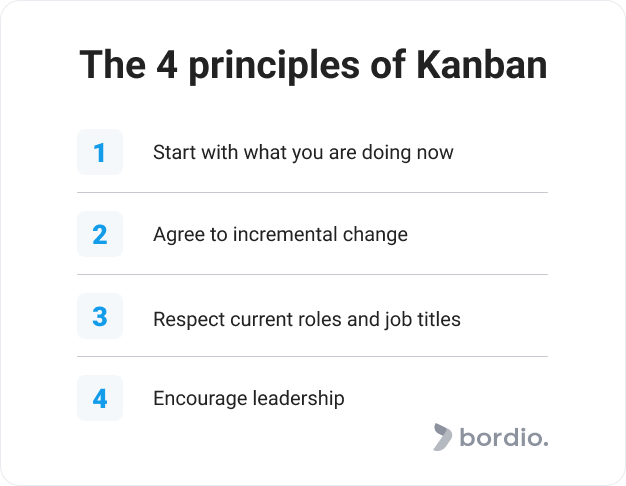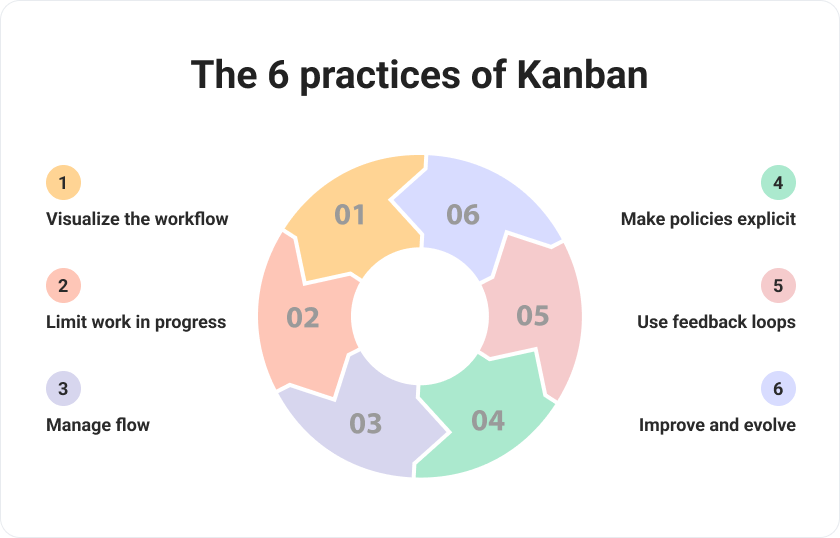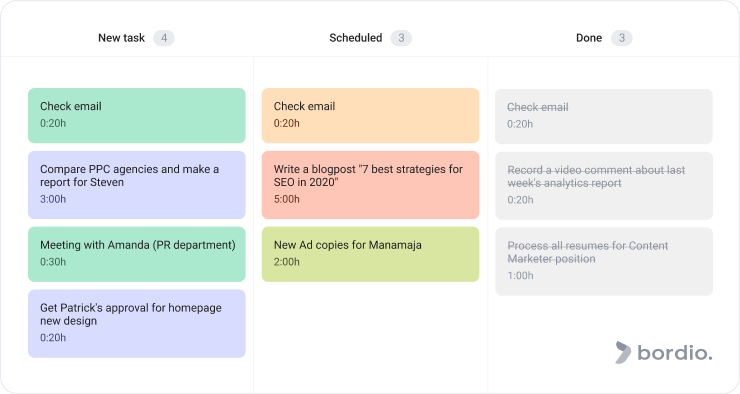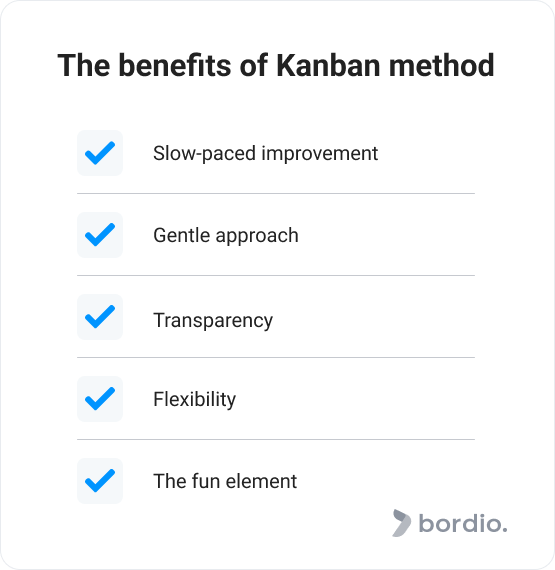In our project-related series of articles, we talk about some of the top concepts in project management, as well as niche, lesser-known principles.
This week we will be uncovering how the Kanban methodology is. Why is it so popular among project managers? What makes it unique? Let’s find out together!
What is Kanban?
Kanban is the approach to work and projects that uses a visual system to manage the workload and promotes gradual improvement.
Kanban visualizes both the workload and the process of going through the tasks with the help of Kanban boards. It strives to avoid the constraints and bottlenecks, and move the project seamlessly at an optimal speed.
What Kanban is not
Technically, it would be incorrect to say that the Kanban method is a project management framework because it doesn’t provide the guidelines on how the project must be executed. Scrum, Lean, Waterfall, and other methodologies go into great detail in talking about the stages that projects must go through and the rituals that must accompany those stages. Kanban, however, is best used as an add-on to one of those methodologies, like Agile, for example.
Kanban boards, in turn, are a great tool that helps manage tasks, balance the workload, and get an instant glance at the state of things
The history of Kanban
The term Kanban originates from a Japanese word that translates as ‘billboard’. And indeed, the most iconic feature of Kanban is the Kanban board that divides the tasks according to their statuses and places them all on the board.
The Kanban method as we know it today was originally introduced by a Toyota engineer who was passionate about optimizing their manufacturing process and got inspired by lean manufacturing. A big part of the change was shifting focus from pushing the products to the market to creating products based on the customer demand (a.k.a. pulling them).
After its introduction in the 1940s, the Kanban method was only gaining popularity and revolutionizing manufacturing processes all over the world.
Somewhere in the early 2000s, the Kanban system eventually landed in software development and got heavily incorporated into the industry’s development process, becoming one of the top methodologies in IT.
Kanban principles
Like any other method, Kanban has its own set of ground rules, practices, and key principles. They should be respected if the team really wants to try the Kanban system, otherwise, it wouldn’t be Kanban.
4 key principles of Kanban
The Kanban system is based on 4 basic principles that each address a different aspect of the professional working process.
Principle 1: Start with what you are doing now
Kanban doesn’t require you to forget about everything you’ve done before and start from scratch. It is quite the opposite, in fact. Kanban principles say that one can start applying this system anytime and implementing it into the existing workflow or process.
Principe 2: Agree to pursue incremental, evolutionary change
Slow and steady wins the race is definitely about Kanban.
Changing everything at once creates disruption and unnecessary risks. A slow, gradual movement towards change paired with continuous improvement is a much more sustainable way to go.
Yes, it takes more time. But we are running a marathon, not sprinting.
Principle 3: Respect current roles, responsibilities, and job titles
Both conservative (e.g. PRINCE2) and flexible (e.g. Lean) methodologies have guidelines and rules to what roles the team should have. Kanban framework really stands out by leaving it completely up to you to decide.
Kanban does not insist on re-grouping your team and hierarchy. Your company might already have a great system in place, so it would be a shame to lose it.
Such freedom is a blessing to some but can be a downside to others. If you are looking for more specifics on how to build your team with some flexibility left, you can read about systems that follow agile principles, like Agile, Scrum, or Lean. Check out our best project management books – list we’ve got a lot of gems there that will guide you in the right direction.
Principle 4: Encourage acts of leadership at all levels
Great ideas come from anywhere, not necessarily only from the top management. Any team member can come up with a revolutionary change for the product, internal process, or anything else that will generate business value.
Kanban is a strong advocate for engaging the entire team in brainstorming and decision-making. Only then are the best results guaranteed when every employee takes the initiative.
Ps – if you’re interested in implementing a board in your workflow, read about Scrum boards that have a lot in common with Kanban boards but also include unique features and rules.
6 core practices of Kanban
The four core principles are paired with six Kanban practices. Let’s see what they are.
Practice 1: Visualize the flow of work
Kanban systems have won themselves a place in people’s hearts thanks to the way they visualize work.
Perhaps the system’s biggest advantage is the Kanban board, which quite literally helps us see the work progress from start to finish. All tasks are written on Kanban cards, and as the task gets a new status, it is moved across the board from left to right.
Such visibility of the working process allows one always to have an overview of the state of things and feel the progress towards a goal.
Practice 2: Limit Work in Progress (WIP)
WIP limits are probably the only aspect of the system that Kanban feels strongly about.
In addition to continuous improvement, Kanban encourages early delivery. And the more tasks you have in progress on your digital to-do list in your simple task planner, the longer the cycle time is for each of those tasks to be finished. So, instead of drowning in multitasking and juggling lots of things at once, it is recommended to focus on fewer jobs, you can plan it with free schedule builder, and get them done quickly before moving on to something else. For the development team, that would mean not starting work on new features before older ones are fully developed. So we suggest planning with online planners, for example with Bordio’s weekly schedule planner online or daily schedule planner online.
Although Kanban promotes WIP limits, it doesn’t say how many are too many. The team can decide individually what is sustainable for them.
Practice 3: Manage flow
The six core practices are closely interconnected with one another. The third practice is about managing the flow of work which supports and simplifies limiting work in progress (WIP). You can use work management platform for this purpose.
Managing the flow is all about moving tasks from the previous stage to the next one as smoothly as possible. To achieve that, the teams would usually need to have a fresh look at their policies and processes to see if there are bottlenecks in the form of excessive bureaucracy, uncooperative managers, or something else. Controlling the workflow is way easyer using time manager online tools.
Practice 4: Make process policies explicit
Kanban doesn’t dictate what your process policies should look like, but they must be clear to everyone on the team.
In a perfect Kanban environment, tasks move quickly on the Kanban board, so there should not be delays caused by someone not understanding what’s going on.
Practice 5: Implement feedback loops
Feedback loops in Kanban should be twofold. They need to come from your team and your clients.
Clients will be sharing their views on the solutions that the company produces: quality, performance, and usability. The team will be providing their view on the internal side of things, like how they feel about the solutions and processes, their suggestions, and ideas to make them better.
Practice 6: Improve collaboratively, evolve experimentally
Last but not least, the sixth practice encourages us not to limit your improvement opportunities. Stay open to new ideas, initiatives, and tools. Don’t be afraid to experiment! And if you’re worried about not having enough time, try one of the techniques to learn faster. Maybe you and your team will try new time organizer soft or else.
How does Kanban work? The Kanban board
The Kanban method is a philosophy that promotes evolutionary change and helps create a system to support it.
The existing workflow is improved step by step. The gradual change makes it less traumatic and risky. Teams have time to adapt, and there is less resistance to change.
Work items (tasks) are pulled from the backlog into the workflow with the key working tool being the Kanban board.
The Kanban board has a number of columns that can look different for each team. However, most Kanban boards have the following columns:
- To do
- Work in progress
- Done
All tasks are placed on the Kanban board to demonstrate the complete workload of the team or individual (Kanban boards can be used if you’re working on your own too).
Each task is assigned a dedicated Kanban card that includes the following information:
- Name
- Description
- Deadline
- Assigned team member (if applicable)
Cards are often divided into groups by colors or sometimes shapes, although colors are definitely the industry standard.
Each Kanban card is first placed in the left column of the board, and it is gradually moved toward the final right column as the task is being worked on. The perfect state of flow is achieved when cards move through the columns without significant delays. All bottlenecks are examined and removed from the process.
If you are looking for an advanced online calendar planner with powerful instruments for project managers and personal productivity, sign up for Bordio and give digital daily planner a try.
Why is the Kanban method so popular?
You might be wondering: what made the Kanban system so appealing to everyone? Well, there are many reasons, and here are the main benefits it provides.
Slow-paced improvement
Kanban helps improve anything that you are doing over a gradual process that is sustainable.
Continuous improvement is a part of many different methodologies, from flexible and adaptive ones like Scrum to more conservative and strict ones like Waterfall. And while Kanban is not unique in its focus on continuous improvement, it stands out through slow and smooth integration into the team’s working process.
Gentle approach
Kanban pioneers a non-disruptive approach to work and improvements. It’s fine if your existing process is not transformed overnight and there are no immediate results.
Transparency
It is very transparent – everyone knows what others are doing, every team member’s online week planner is visible, the workload is clear, and any bottlenecks can be spotted right away.
In many teams, especially when it comes to software development, the key role of the project manager is to guide the team and facilitate their work, instead of actively managing and standing in the way. The levels of transparency and visibility that Kanban offers leave PMs assured that their teams know what they should be doing and when. As a result, such a non-invasive yet efficient system boosts creativity and promotes focus on important tasks.
Flexibility
One of the greatest perks of choosing to implement Kanban is that it’s very flexible.
Kanban doesn’t dictate what comes after what. It allows for adjustments if priorities and circumstances change, and doesn’t pressure us into turning our business processes into something completely different if we don’t want to.
Helps work more efficiently
Through its many practices and principles, Kanban enables us to bring products and services to the market faster. It cuts out toxic or redundant activities that lead to better efficiency. And better efficiency means higher execution speed with fewer mistakes.
It’s just fun!
The Kanban board is an extremely fun gamification tool.
You attach Kanban cards on the board (or assign them in the software) and move those cards as you go – what’s not to love here? CEOs and managers know how addictive and exciting all kinds of colorful dashboards, metrics, and boards are; that’s why they are so widespread in the business world.
Besides the fun element of it, seeing those cards slowly move towards ‘done’ columns gives us a feeling of satisfaction and accomplishment.
The role of WIP limit
The Kanban system doesn’t enforce many process policies on us. But it clearly tells us to stop starting and start finishing the tasks.
Placing WIP limits for the team helps, for example in team planning software, reduce the multitasking and focus on finishing work sooner and getting better results. Instead of dragging half-done tasks while tackling more and more new ones, the Kanban method encourages us to finish the current workload first, and only then move to the new work.
It’s good for morale, motivation, and efficiency when we limit work in progress. Finishing tasks more often gives a sense of accomplishment that development teams so desperately need in rushed, chaotic environments of projects. Besides, dragging the work for long periods of time adds unnecessary risk to the project.
If you don’t think that a WIP limit is necessary – make an analogy with your daily planner. How many tasks do you have that are dragged into the next day again and again without any closure? Whenever we add too many things to our to-do lists, we make ourselves less focused. Anxiety to finish everything only results in us achieving less in the end. But if you limit your task list to 5 or 6 items per day, you are more likely to cross them all out and feel accomplished.
Final thoughts on Kanban methodology
The Kanban method is a beautiful approach to work in general and for projects specifically. And while it has become legendary thanks to the Kanban board, it is much more than just the work visualization method.
Kanban teaches us to move slowly but surely and not spread ourselves too thin:
- WIP limits ensure the work gets done and the progress is steady.
- Respect for current roles helps avoid conflicts and objections to changes.
- Encouragement of leadership across all boards boosts engagement and gives the development team a sense of ownership.

